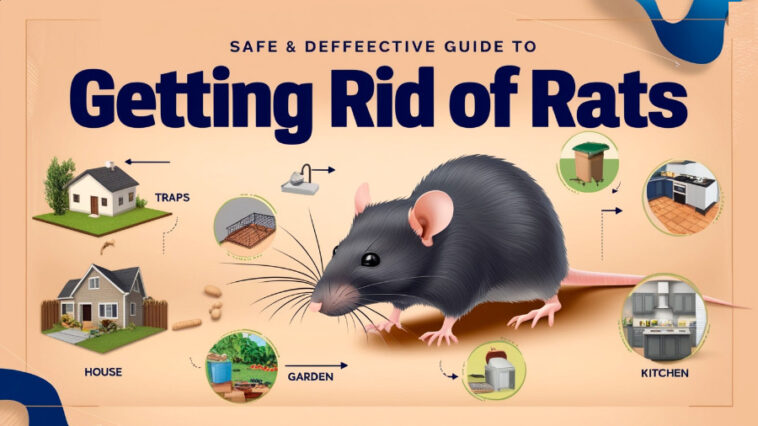Learn about recognizing and addressing rat infestations effectively. Discover natural methods, home remedies, and pet-safe solutions to eliminate rats from your home and garden. Understand the signs of rat activity and implement long-term prevention strategies to maintain a rat-free environment.
Introduction: Understanding the Rat Problem
Rats are a ubiquitous pest, notorious for invading households and gardens. Their ability to adapt to various environments makes them a prevalent problem. Recognizing the signs of a rat infestation at the earliest stage is pivotal in mitigating the potential damage they can inflict. Rats are known carriers of numerous diseases, such as leptospirosis, hantavirus, and salmonellosis, which pose significant health risks to humans and pets alike. Furthermore, their chewing behavior can lead to structural damage, gnawed wires, and contaminated food supplies.
Households and gardens provide rats with plentiful food sources and shelter. Urban settings, in particular, attract these rodents due to improperly disposed of waste and easily accessible nesting sites. Once established, rats reproduce rapidly, compounding the problem exponentially if not addressed promptly.
Detecting rat activity early can prevent a minor infestation from evolving into a major headache. Key indicators of a rat infestation include droppings, gnaw marks, and unusual noises such as scratching or squeaking, often heard at night. Additionally, spotting greasy rub marks along walls or noticing burrows in gardens are clear signs of rat presence. Comprehensive awareness and understanding of these signs can significantly influence the effectiveness of pest control measures implemented thereafter.
Addressing a rat infestation is about more than just managing an inconvenience; it is crucial for maintaining a safe and hygienic living environment. Taking proactive steps to identify and manage rat problems can protect your property from extensive damage and safeguard your health and that of your family. This guide aims to arm you with the necessary knowledge and methods to effectively and sustainably eliminate rats from your premises, ensuring a rat-free home and garden.
Identifying Rat Infestations
Recognizing the early signs of a rat infestation is crucial for addressing the issue promptly and effectively. Common indicators include droppings, gnaw marks, and nesting materials. Rat droppings are usually dark and about the size of a grain of rice, often found along common rat pathways such as kitchen counters, pantries, and behind appliances. These droppings can help identify the presence and active areas of infestation.
Gnaw marks are another telltale sign. Rats need to constantly chew on objects to keep their continuously growing teeth in check. You may notice gnaw marks on wooden structures, electrical wiring, or plastic items. Damaged food containers and chewed furniture are all indicators of their presence. Additionally, rats tend to build nests using shredded paper, fabric, or plant matter, often found in hidden, undisturbed locations like attics, basements, or behind walls.
Understanding rat behavior can also aid in detection. Rats are nocturnal creatures, primarily active during the night. Hearing scratching or scurrying sounds within walls, ceilings, or floorboards at night can suggest an infestation. If you notice rats during daylight hours, it may indicate a large infestation has forced them to search for food outside their usual nocturnal schedule.
Physical sightings of rats are a clear indication, but these should not be the only reliance to detect an infestation. Consider other signs like oily rub marks along walls, footprints in dusty areas, and a musky odor in enclosed spaces that have developed over time. Monitoring these signs can provide early warnings and help take timely action to manage and eliminate the infestation effectively.
Natural Methods to Get Rid of Rats in the Garden
Rats can be a persistent problem in gardens, but there are several natural and environmentally friendly methods to eliminate them without causing harm to the ecosystem. One effective strategy is the use of peppermint oil. Rats find the strong scent of peppermint overwhelming, which makes it an excellent deterrent. To use this method, simply soak cotton balls in peppermint oil and place them around the garden, focusing on areas where rat activity is most noticeable.
Incorporating certain types of flora can also help to naturally repel rats from your garden. Plants such as mint, lavender, and daffodils are known to deter rodents due to their strong scents and taste aversion. Planting these around perimeters and areas prone to rat infestation can create a natural barrier that discourages them from entering.
Another highly effective method is to attract natural predators into your garden. Owls, hawks, and certain types of snakes are natural rat predators. By installing owl boxes and providing a conducive environment for these predators, you can reduce the rat population organically. Additionally, encouraging birds of prey by setting up perches can further enhance this natural control method.
A clean garden environment is essential in preventing rat infestations. Regularly removing fallen fruits, securing compost bins, and eliminating potential nesting sites such as piles of wood or debris can significantly deter rats. Keeping the garden well-maintained makes it less attractive for rodents looking for food and shelter.
By integrating these natural methods, you create a balanced approach to managing rats that aligns with environmental sustainability. These techniques not only help maintain a healthy garden ecosystem but also ensure that rat control is achieved without the use of harmful chemicals or traps, promoting a safe outdoor space for both plants and wildlife.
Home Remedies for Instant Rat Kill
When dealing with a rat infestation, many homeowners prefer quick and effective solutions that can be readily implemented using common household items. This section aims to provide a detailed guide on effective home remedies that ensure immediate results, focusing on safe, lethal methods.
An easily accessible and highly effective method for killing rats is the use of baking soda. Rats cannot burp or vomit, making this substance particularly deadly. When ingested, baking soda reacts with the rat’s stomach acids, producing gas that cannot be expelled, ultimately leading to a lethal buildup of pressure. To administer this remedy, mix one part baking soda with one part sugar to lure the rats. Sugar effectively attracts the rats, masking the taste of the baking soda.
Another powerful home remedy involves using plaster of Paris. This substance hardens and expands when it comes into contact with moisture. To execute this method, combine equal parts of plaster of Paris with flour and a small quantity of sugar or cocoa powder to attract the rats. The mixture forms into a dough-like consistency that rats find palatable. Once ingested, it reacts with the moisture in their stomachs, hardening and leading to intestinal blockage and death.
Instant potato flakes are another readily available item that can be surprisingly effective against rats. Spread these flakes in areas where rat activity has been observed. When the rats consume the flakes and drink water, the flakes expand significantly in their stomachs, causing fatal bloating.
All these methods provide an efficient, swift resolution to rat infestations without the need for commercially available poisons. However, employing these home remedies also requires certain precautions. Ensure you place these mixtures in locations inaccessible to pets and children to avoid inadvertent ingestion.
Utilizing these household items makes it not only convenient but also cost-effective to manage rat problems. By understanding and deploying the right home remedies, homeowners can achieve rapid, decisive results in eliminating these unwelcome intruders.
Humane Solutions: Getting Rid of Rats Without Killing Them
Dealing with a rat infestation humanely requires strategic measures that prioritize the animals’ well-being while ensuring they vacate your property. We will delve into non-lethal methods, including the usage of live traps, natural repellents like ammonia or vinegar, and adjustments to the environment that deter rats.
Live traps provide a compassionate solution for capturing rats without causing harm. These traps lure rats inside with bait, typically something they find irresistible such as peanut butter or fruit. Once inside, the trap’s mechanism closes, securing the rat. Regularly checking these traps is essential to minimize stress and ensure successful relocation. After capturing a rat, it is advisable to release it at least a mile away from your home to prevent it from finding its way back. Always wear protective gloves when handling traps and rats to minimize health risks.
Natural repellents are another effective and humane way to deter rats. Ammonia and vinegar are notable for their strong scents, which are unpleasant to rats. To employ these repellents, soak cotton balls in either ammonia or vinegar and place them in areas where rats frequent. While these scents are powerful to rats, they are generally safe for households and pets when used cautiously. Regularly refreshing the cotton balls is necessary to maintain their efficacy as deterrents.
Making your environment unattractive to rats is perhaps the most sustainable approach. Rats are drawn to food, water, and shelter; eliminating these attractants is key. Secure food sources in sealed containers, clean up spills immediately, and ensure garbage cans are tightly closed. Additionally, fixing leaks and removing standing water sources deprives rats of their necessary hydration. Decluttering and sealing any gaps or holes in walls, floors, and foundations can further prevent them from accessing your home.
Implementing these humane methods not only aligns with ethical treatment of animals but also fosters a safer and cleaner living environment. Through live traps, natural repellents, and making the environment less inviting to rats, you can effectively manage and prevent rat infestations in a compassionate way.
Pet-Safe Rat Removal from Yards
Ensuring the safety of household pets while addressing a rat infestation in your yard is of paramount importance. Fortunately, there are several methods to eliminate rats that do not pose risks to pets. One of the safest strategies involves using pet-safe repellents. These repellents, often made from natural ingredients, can be effective in deterring rats without causing harm to animals. Common components include peppermint oil, which is known to be a natural rodent repellent. Applying such repellents along the perimeter of your yard and near known rat entry points can be an effective first step.
In addition to repellents, pet-safe traps can also play a crucial role in rat removal. Live traps, also known as humane traps, can capture rats without harming them or your pets. Once caught, the rats can be relocated far from residential areas, ensuring they do not return. When setting these traps, it’s imperative to place them in areas inaccessible to pets to prevent accidental engagement.
Barriers are another essential component in making your yard less appealing to rats while keeping your pets safe. Installing hardware cloth around the base of your fences and covering potential entry points such as vents or gaps in decking can prevent rats from entering your yard. Ensuring that food sources, such as pet food or bird feeders, are securely stored will also minimize the attraction for rats.
Monitoring the yard is a continuous process; regular inspections can help in early detection of rat activity. Keep an eye out for droppings, gnaw marks, and burrows. Additionally, employing motion sensor cameras can aid in the identification of active rat pathways while ensuring your pets’ movements are unhindered.
By integrating these pet-safe methods—repellents, humane traps, and barriers—you can effectively manage rat infestations without jeopardizing the health and safety of your pets. Regular monitoring and timely intervention are key to maintaining a rat-free yard.
Fast and Effective Ways to Eliminate Rats from Your Home
Dealing with a rat infestation in your home can be both alarming and urgent. Fast and effective strategies to eliminate rats not only ensure your safety but also protect your property from damage. The first step in rat eradication is sealing any potential entry points. Inspect your home meticulously, examining gaps in doors, windows, and foundations. Use materials such as steel wool and caulk to block these openings, thus cutting off rats’ access to your living spaces.
Another critical component in getting rid of rats is maintaining cleanliness. Rats are drawn to areas where food and water are readily available. Make it a habit to store food in airtight containers, dispose of garbage regularly, and clean up crumbs and spills immediately. Additionally, ensure that pet food is not left out overnight, as it can attract rats.
Using rat traps is a direct and effective way to capture and remove rats from your home. There are several types of traps to consider. Snap traps are a traditional choice and can humanely kill rats instantly. For a no-contact approach, consider using electronic traps, which deliver a lethal shock to the rodent. It is essential to place these traps along walls, behind appliances, and in other areas where rat activity is prevalent.
In cases of severe infestations, emergency measures may be necessary. If you notice a rapid increase in rodent activity, it may be time to contact pest control professionals. Experienced exterminators can assess the severity of the infestation and utilize advanced methods such as fumigation or rodenticides, ensuring comprehensive rat removal.
Implementing these strategies—sealing entry points, maintaining cleanliness, and using rat traps—can significantly reduce and eventually eliminate rat populations within your home. For emergency infestations, do not hesitate to seek professional help to restore a rat-free environment swiftly.
Long-Term Prevention Strategies Against Rats
Ensuring permanent rat control requires a focus on long-term prevention strategies aimed at creating an environment where rats cannot thrive. Environmental management is the cornerstone of preventing future rat infestations. Start by eliminating sources of food, water, and shelter that attract these pests. Regularly clean up spills and store food in sealed containers. Proper waste management, such as using rodent-proof bins, will also deter rats from scavenging in your property.
Effective environmental management extends beyond mere cleanliness to structural maintenance. Inspect your property regularly for any signs of potential entry points, such as holes, cracks, or broken vents. Seal these gaps using materials like steel wool or caulk, as rats are capable of squeezing through very small openings. Ensuring doors have proper sweeps and window screens are intact can further reduce the chances of these rodents gaining entry.
Consistent inspections play a crucial role in early detection and preventing severe infestations. Perform thorough inspections of dark, seldom-used areas where rats are likely to hide. Look for signs of rat activity, including droppings, gnaw marks, or shredded materials used for nesting. If possible, use motion sensor cameras in attics, basements, or other concealed spaces to monitor for nocturnal rodent activity.
In addition to inspections, proactive maintenance is indispensable. This includes trimming vegetation around your home, especially any branches that may provide easy access to the roof. Keep woodpiles and outdoor storage raised and away from walls. Address any plumbing leaks promptly since rats are often drawn to water sources. Routine maintenance of these aspects will make your property less attractive to rodents.
Employing these long-term prevention strategies not only aids in keeping rats at bay but also fosters a healthier living environment. By consistently monitoring and adapting your approach, you can effectively prevent these persistent pests from regaining a foothold in your home.




GIPHY App Key not set. Please check settings